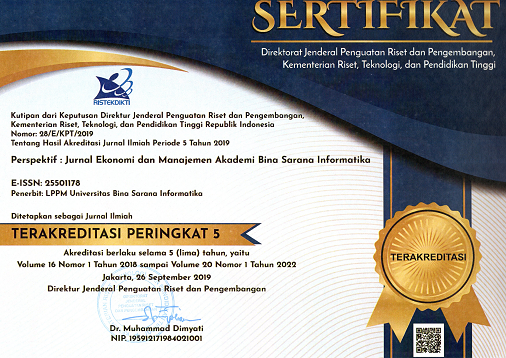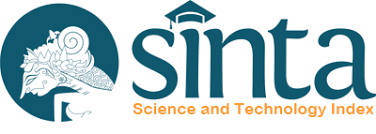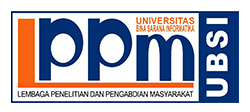Virtual Influencer Attractiveness dan Niat Beli : Peran Mediasi Daya Tarik Produk
Abstract
Abstrak - Meningkatnya penggunaan virtual influencer dalam strategi pemasaran digital mendorong perlunya kajian mengenai pengaruh daya tarik fisik virtual influencer terhadap niat beli konsumen. Penelitian ini bertujuan mengkaji pengaruh langsung maupun tidak langsung dari daya tarik fisik virtual influencer terhadap niat beli konsumen, dengan mempertimbangkan daya tarik ptoduk sebagai mediator. Penelitian ini menggunakan pendekatan kuantitatif dengan desain cross – sectional. Sampel sebanyak 218 responden merupakan pengguna media sosial di Indonesia yang pernah melihat konten virtual influencer dan mengetahui produk yang dipromosikan nya. Teknik analisis data menggunakan Partial Least Square – Structural Equation Modeling (PLS-SEM) dengan bantuan SmartPLS 4. Uji yang dilakukan meliputi validitas konvergen dan diskriminan,reliabilitas, R2, path coefficients, serta uji mediasi. Hasil penelitian menunjukan semua hipotesis diterima: daya tarik fisik berpengaruh positif signifikan terhadap daya tarik produk dan niat beli, serta daya tarik produk memediasi secara parsial hubungan tersebut. Secara teoritis, penelitian ini memperluas literatur pemasaran digital terkait virtual influencer. Secara praktis, hasil ini dapat digunakan oleh pelaku bisnis untuk merancang strategi promosi hybrid yang efektif dengan melakukan kolaborasi antara virtual influencer dengan influencer manusia.
Kata Kunci: Daya Tarik Fisik, Daya Tarik Produk, Niat beli
Abstract - The growing use of virtual influencers in digital marketing strategies highlights the need to examine the influence of virtual influencers’ physical attractiveness on consumer purchase intention. This study aims to examine the direct and indirect effects of a virtual influencer’s physical attractiveness on consumer’s purchase intention, considering product attractiveness as a mediator. This research adopts a quantitative approach with a cross-sectional design. The sample consists of 218 respondents who are social media users in Indonesia, have seen virtual influencer content and are familiar with the promoted products. Data analysis was conducted using Partial Least Square – Structural Equation Modeling (PLS-SEM) with the help of SmartPLS 4. Tests include convergent and discriminant validity, reliability, R², path coefficients, and mediation analysis. The results of data analysis show that all hypotheses are accepted: physical attractiveness has a positive and significant effect on product attractiveness and purchase intention, and product attractiveness partially mediates the relationship. Theoretically, this study contributes to the digital marketing literature related to virtual influencers. Practically, this result can be used by business owner to design an effective hybrid promotion strategy by collaborating between virtual influencers and human influencers.
Keywords: Physical Attractiveness, Product Attractiveness, Purchase Intention
Full Text:
PDFReferences
REFERENSI
AlFarraj, O., Alalwan, A. A., Obeidat, Z. M., Baabdullah, A., Aldmour, R., & Al-Haddad, S. (2021). Examining the impact of influencers’ credibility dimensions: attractiveness, trustworthiness and expertise on the purchase intention in the aesthetic dermatology industry. Review of International Business and Strategy, 31(3), 355–374. https://doi.org/10.1108/RIBS-07-2020-0089
Arafat, M. Y. (2018). Pengaruh citra tubuh ideal dan daya tarik fisik terhadap kemampuan interpersonal pada pria yang berolahraga di pusat kebugaran atau fitness center di. Psikoborneo, 6(4), 748–762.
Bell, E., Harley, B., & Bryman, A. (2022). Business research methods sixth edition. Oxford University Press.
Boissinot, J. (2025). Here’s the list of the Top 20 Virtual Influencers in 2025. Favikon.Com. https://www.favikon.com/blog/top-virtual-influencers
Chang, C. M., Yen, C., Chou, S. Y., & Lo, W. W. (2023). What motivates viewers to purchase recommended products in live streaming? The moderating role of extroversion–introversion personality. Asia Pacific Journal of Marketing and Logistics, 35(12), 2983–3007. https://doi.org/10.1108/APJML-07-2022-0582
Cheng, J., & Wang, J. (2024). Influencer-product attractiveness transference in interactive fashion marketing: the moderated moderating effect of speciesism against AI. Journal of Research in Interactive Marketing, 19(4), 712-729. https://doi.org/10.1108/JRIM-06-2024-0299
Chiu, C. L., & Ho, H. C. (2023). Impact of celebrity, Micro-celebrity, and virtual influencers on Chinese gen z’s purchase intention through social media. SAGE Open, 13(1), 1–18. https://doi.org/10.1177/21582440231164034
Dincer, C., & Dincer, B. (2023). Social commerce and purchase intention: A brief look at the Last decade by Bibliometrics. Sustainability, 15(1), 846. https://doi.org/10.3390/su15010846
Fahmi, S. (2023). Pengaruh promosi, Harga dan daya tarik produk terhadap minat konsumen untuk beralih menggunakan sepeda listrik. Jurnal Aplikasi Manajemen Dan Inovasi Bisnis, 6(1), 92. https://doi.org/10.47201/jamin.v6i1.199
Gambetti, R. C., & Kozinets, R. V. (2024). From killer bunnies to talking cupcakes: theorizing the diverse universe of virtual influencers. European Journal of Marketing, 58(13), 205–251. https://doi.org/10.1108/EJM-12-2022-0948
Geyser, W. (2024). What is Influencer Marketing? – The Ultimate Guide for 2025. Diakses dari https://influencermarketinghub.com/influencer-marketing/
Hair, J. F., Hult, G. T. M., Ringle, C. M., Sarstedt, M., Danks, N. P., & Ray, S. (2021). Partial least squares structural equation modeling (PLS-SEM) using R. Springer International Publishing. https://doi.org/10.1007/978-3-030-80519-7
Hofeditz, L., Nissen, A., Schütte, R., & Mirbabaie, M. (2022). Trust me, I’m an influencer!-A comparison of perceived trust in human and virtual influencers. ResearchGate, 27(June), 1451. https://www.researchgate.net/publication/360370805
Kim, H., & Park, M. (2023). Virtual influencers’ attractiveness effect on purchase intention: A moderated mediation model of the product–endorser fit with the brand. Computers in Human Behavior, 143(February), 107703. https://doi.org/10.1016/j.chb.2023.107703
Oktavioni, V. (2025). Viral! Arbie Seo, Metahuman Indonesia ciptaan Aelke Mariskha. Pojoksatu.Id. Diakses dari https://www.pojoksatu.id/teknologi/1083330816/viral-arbie-seo-metahuman-indonesia-ciptaan-aelke-mariskha
Pamungkas, S. Y., & Ayuanti, R. N. (2024). The influence of customer value, Product quality, and product attractiveness on consumer purchasing interest in UMKM in Jamu Kampung Kediri City. Asian Journal of Management Analytics, 3(2), 549–566. https://doi.org/10.55927/ajma.v3i2.8600
Pramezwary, A., Juliana, J., Winata, J., Tanesha, R., & Armando, T. (2021). Brand trust dan promosi penjualan terhadap keputusan pembelian produk di masa Covid-19. Jurnal Perspektif, 19(1), 24–31. https://doi.org/10.31294/jp.v19i1.9376
Rahma, G. A., Nasution, S. A., Rosyidani, N. M., Putri, M., & Ervynasari, A. (2023). Analisis pengaruh daya tarik fisik influencer pada kepercayaan masyarakat terhadap minat pembelian suatu produk. Economics Business Finance and Entrepreneurship, (Agustus), 43–52.
Saputra, A. M., Yusrawati, Maihani, S., Safrina, E., & Murniyanti, S. (2024). The impact of lifestyle and product attractiveness on purchasing decisions Aceh SMEs coffee products. Jurnal Ekonomi, Manajemen, dan Akutansi, 10(6), 3145-3153. https://doi.org/10.35870/jemsi.v10i6.3264
Scarpi, D., Pizzi, G., & Raggiotto, F. (2019). The extraordinary attraction of being ordinary: A moderated mediation model of purchase for prototypical products. Journal of Retailing and Consumer Services, 49(March), 267–278. https://doi.org/10.1016/j.jretconser.2019.03.006
Shen, X. L., Li, Y. J., Sun, Y., Chen, Z., & Wang, F. (2019). Understanding the role of technology attractiveness in promoting social commerce engagement: Moderating effect of personal interest. Information and Management, 56(2), 294–305. https://doi.org/10.1016/j.im.2018.09.006
Soler-Anguiano, F. L., Zeelenberg, M., & Díaz-Loving, R. (2023). The interaction of product attractiveness and decision-making style on consumer purchase intention: A cultural moderation perspective. Journal of International Consumer Marketing, 35(1), 19–29. https://doi.org/10.1080/08961530.2021.2023829
Sugiyono. (2020). Metodelogi Penelitian Kuantiatif ,Kualitatif dan R&D. Alfabeta.
Yang, D., Zhang, J., Sun, Y., & Huang, Z. (2024). Showing usage behavior or not? The effect of virtual influencers’ product usage behavior on consumers. Journal of Retailing and Consumer Services, 79(November 2023), 103859. https://doi.org/10.1016/j.jretconser.2024.103859
Yu, T., Teoh, A. P., Bian, Q., Liao, J., & Wang, C. (2024). Can virtual influencers affect purchase intentions in tourism and hospitality e-commerce live streaming? An empirical study in China. International Journal of Contemporary Hospitality Management, 37(1), 216-238. https://doi.org/10.1108/IJCHM-03-2024-0358
DOI: https://doi.org/10.31294/jp.v23i2.26130
Copyright (c) 2025 Anthony Sugata, Rully Arlan Tjahyadi

This work is licensed under a Creative Commons Attribution-ShareAlike 4.0 International License.
dipublikasikan oleh LPPM Universitas Bina Sarana Informatika Jakarta
Jl. Kramat Raya No.98, Kwitang, Kec. Senen, Kota Jakarta Pusat, DKI Jakarta 10450

This work is licensed under a Creative Commons Attribution-ShareAlike 4.0 International License









